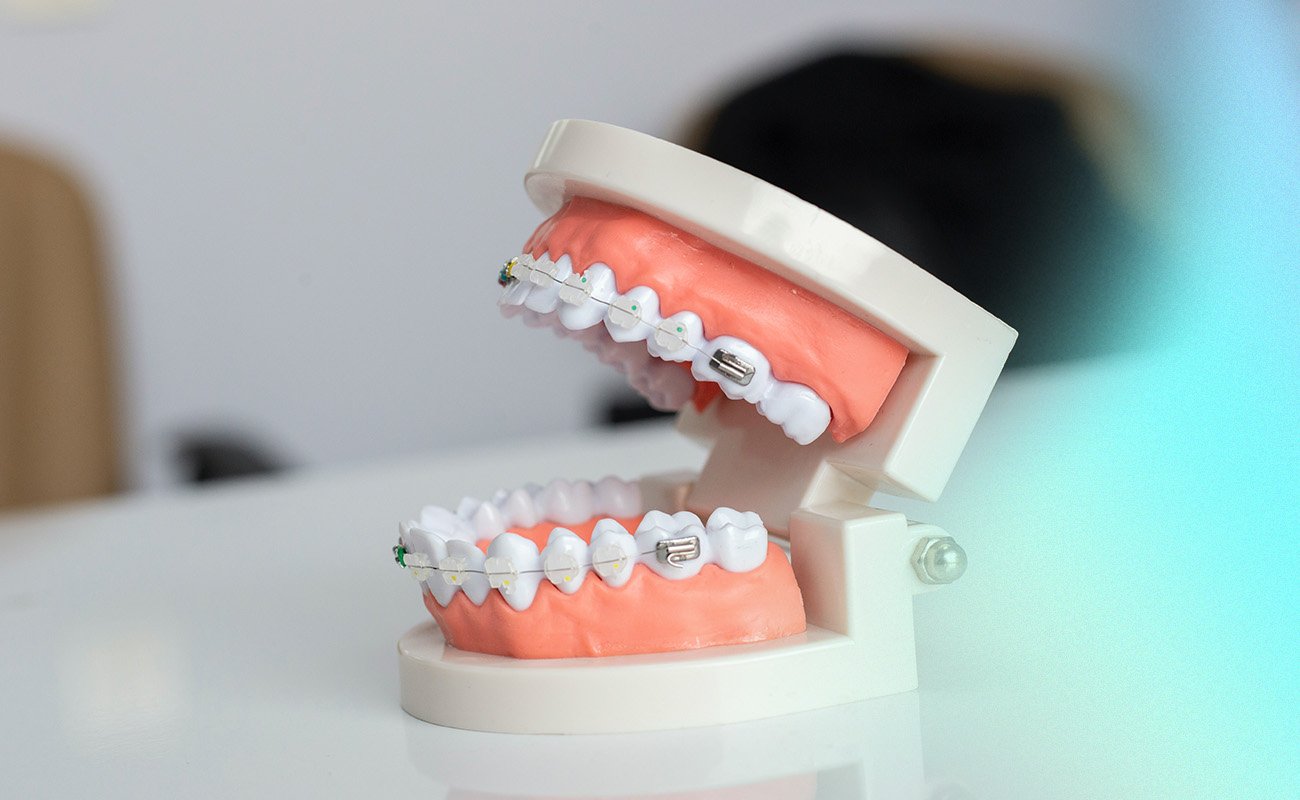Invisible braces have become a popular option for those looking for discreet and effective orthodontic treatment for straightening teeth. They come in different types, each with unique benefits and considerations.
Our guide to Types of Invisible Braces explores the options, including clear aligners, ceramic braces, and lingual braces, and highlights the pros and cons of each. Discover which invisible braces may be the best fit for you.
Types of Invisible Braces
Worth Knowing
The study published on PubMed Central reveals that a significant number of adults favor discreet orthodontic solutions like aligners or lingual braces.
Clear Braces
Clear braces, also known as ceramic braces, are made from a composite material that reacts to light and can mimic the natural color of one’s teeth. This feature allows them to function just like traditional metal braces, but with a significant aesthetic advantage: their clear or tooth-colored components make them much less noticeable, appealing to those who prefer a more discreet orthodontic treatment.
These braces are designed with brackets that attach to each tooth, using crystal-clear or tooth-colored elastics, known as ligatures, to hold the archwire in place. Clear braces are metal-free, which makes them a gentler option for the gums and cheeks, reducing the irritation and discomfort often associated with traditional braces.
However, a notable downside of clear braces is their susceptibility to staining. The materials used, while aesthetically pleasing, can absorb colors from certain foods, drinks, and smoking, potentially leading to visible discoloration over time. This requires patients to be more mindful of their consumption habits and to maintain rigorous oral hygiene to minimize staining.
See also: What Stains Ceramic Braces? Causes and Prevention Tips
Lingual Braces
Lingual braces offer a unique and virtually invisible orthodontic treatment option, as they are placed behind the teeth, facing the tongue. They work on the same principle as traditional braces, applying gradual pressure to teeth to shift them into the desired alignment, but their hidden placement sets them apart in terms of discretion. Since lingual braces cannot be seen, patients can go through the entire treatment without worrying about people noticing that they have braces.
Constructed from high-grade metal, lingual braces are custom-fitted to the individual contours of each tooth, ensuring a precise and comfortable fit. The customization process involves detailed impressions of the teeth, which are then used to create braces that match the unique shape of each patient’s dental structure.
One of the challenges with lingual braces, however, is their adjustment period. Due to their placement close to the tongue, some patients may initially experience discomfort or a slight impact on speech. Moreover, maintaining oral hygiene can be more demanding, as the location of the braces requires more meticulous cleaning techniques to prevent plaque buildup and ensure optimal oral health.
Clear Aligners
Clear aligners offer a modern, nearly invisible solution for straightening teeth. Made from a durable, clear plastic material, these aligners are custom-fitted to the unique contours of an individual’s teeth, ensuring a comfortable and effective fit. The design of clear aligners allows for easy removal, facilitating normal eating and oral hygiene practices, such as brushing and flossing, without the complications often associated with traditional braces.
One of the key advantages of clear aligners is their aesthetic appeal, as they are virtually undetectable when worn. However, their effectiveness is highly dependent on the wearer’s commitment to keeping them in place for the recommended 20 to 22 hours per day. Failure to wear the aligners for the prescribed duration can extend the treatment time and potentially compromise the desired results.
Clear aligners are suited for a wide range of orthodontic issues, from minor tooth movements to more complex cases of misalignment. The treatment process involves a series of aligners, each designed to make gradual adjustments to the teeth’s position. Typically, each set is worn for about two weeks before progressing to the next in the series, gradually shifting the teeth towards their optimal alignment.
See our article: Invisible Braces – How They Work?
How Much Do Invisible Braces Cost?
The cost of invisible braces can vary significantly, mainly influenced by the complexity of the dental issues being addressed. More severe cases often require more extensive work and frequent appointments, which can affect the overall price. Additionally, the choice of materials and customization involved in certain orthodontic solutions can also impact costs.
Clear ceramic braces, for example, typically range from $4,000 to $8,000, offering a balance between aesthetics and affordability. On the higher end, lingual braces, which are placed behind the teeth and are not visible, may cost between $8,000 to $10,000, reflecting their complexity and the precision needed for customization. Invisalign, a well-known brand of clear aligners, can vary in price from $3,000 to $8,000, depending on the treatment plan and duration. For those looking for a more budget-friendly option, at-home clear aligners start at around $1,000, though they may not be suitable for all orthodontic issues.
Which Braces Work Fastest?
The duration of treatment with different types of braces can vary based on several factors, making it difficult to determine which option works fastest. The timeline is influenced by factors such as the severity of the case, the patient’s age, and their commitment to oral hygiene and following treatment guidelines.
Clear braces typically require 12 to 36 months, with an average of around 24 months, while lingual braces may also take 1 to 3 years. Aligners are often considered among the faster options, particularly for mild cases, with noticeable results seen within approximately 6 months and an average treatment duration ranging from 12 to 24 months.
See our article: Quickest Way to Straighten Teeth.
Which Invisible Braces Should You Choose?
If a patient has a severe teeth straightening issue it is recommended to opt for either clear or lingual braces. Clear braces are the best option for someone who wants to start their treatment sooner as lingual braces can have a longer preparation time. Lingual braces however do offer increased discretion to clear braces as they sit behind the teeth and are completely invisible.
Aligners are the best option for patients with mild to mid-level issues with their teeth. These are the quickest to prepare in terms of starting treatment, and the most affordable. They also offer an effective result for treatment and require much less maintenance.
Here is a selection of the best clear aligners with pros and cons.
AlignerCo is a well-known brand that provides an affordable aligner program. Their prices are lower than most other aligner brands, with treatment starting at just $945, which also includes free retainers and a teeth whitening kit.

AlignerCo
The cheapest at-home aligners, with monthly plans, no down payment, and considerable discounts.
Check out AlignerCo AlignersNewSmile is one of the newest aligner brands on the market and is known for its affordability. When you purchase their aligners, you receive an impression kit, whitening foam, aligners, and retainers. This brand also provides monthly payment plans without requiring any initial payments, offers a video call option with a specialist to assist with mouth impressions, and has a user-friendly online assessment process.

NewSmile
Affordable at-home treatment with positive reviews offering superior look and comfort.
Check out NewSmile AlignersByte is a well-known brand that offers a lifetime guarantee for your aligners. This means that if your teeth don’t stay in the desired treatment position afterward, you’ll receive additional impression kits, treatment plans, and sets of aligners at no additional cost to correct any misalignments.

Byte
An affordable option with refundable impression kits, free HyperByte, and a Byte for Life guarantee.
Check out Byte AlignersCandid is a highly regarded aligner product with a treatment approach similar to Invisalign. Unlike the other brands mentioned, Candid doesn’t offer a direct-to-home ordering service. Instead, a qualified orthodontist will assess your eligibility for treatment. The advantage is that you won’t need regular appointments after starting treatment. Candid aligners are suitable for addressing both mild and severe spacing issues.

Candid
A hybrid of in-office and at-home treatment that provides 1-on-1 orthodontist support.
Check out Candid AlignersTypes of Invisible Braces – Conclusion
Invisible braces are orthodontic devices designed to help straighten teeth discreetly. They include teeth straightening solutions such as clear braces, lingual braces, and clear aligners.
Clear braces are similar to traditional metal braces in that brackets and wires are used, but the material is tooth-colored rather than metal. Lingual braces are placed behind the teeth so they’re not visible when smiling, talking, or laughing. Clear aligners look like a mouthguard and are worn over the teeth, typically for up to 22 hours per day while gradually shifting teeth into their desired positions.
While invisible braces might not work for every patient’s unique dental situation, they typically offer patients the same results as conventional braces with more comfort and convenience.
This form of braces is ideal for teens and adults who want to correct problems with overbites, underbites, crooked teeth, or gaps between teeth. Invisible braces are an effective way to get the straight smile that many people desire while allowing them to maintain a natural appearance during their course of treatment.
Frequently Asked Questions
What are the Most Effective Invisible Braces?
The most effective invisible braces largely depend on the severity of the issue it is being used to treat.
For very severe teeth straightening issues it is best to stick with more traditional braces such as clear braces. Lingual braces are as effective but are at an increased cost and require more maintenance and appointments.
Clear aligners are the most effective for mild teeth straightening issues and also give results in a shorter time.
Are There Different Types of Invisible Braces?
There are several types of braces but the most popular are clear braces, lingual braces, or clear aligners.
Clear braces are made of clear materials and sit on your teeth in the same way as metal braces but offer more discretion. Lingual braces sit inside your teeth so are completely invisible. Clear aligners sit over the teeth and their transparent nature makes them practically invisible to anyone else.
Sources:
Jaber, S. T., Hajeer, M. Y., Sultan, K., Treatment Effectiveness of Clear Aligners in Correcting Complicated and Severe Malocclusion Cases Compared to Fixed Orthodontic Appliances: A Systematic Review, Cureus. 2023 Apr; 15(4): e38311. DOI: 10.7759/cureus.38311. Available online at: https://www.ncbi.nlm.nih.gov/pmc/articles/PMC10148732/
Alajmi S., Shaban A, Al-Azemi R. Comparison of short-term oral impacts experienced by patients treated with Invisalign or conventional fixed orthodontic appliances. Medical Principles and Practice. 2019. Available online at: https://pubmed.ncbi.nlm.nih.gov/31842018/
Buschang, P.H., Shaw S.G., Ross M., Crosby D., Campbell P.M., Comparative time efficiency of aligner therapy and conventional edgewise braces. Angle Orthod (2014). DOI: 10.2319/062113-466. Available online at: https://meridian.allenpress.com/angle-orthodontist/article/84/3/391/58505/
Ke, Y. et al. A comparison of treatment effectiveness between clear aligner and fixed appliance therapies. BMC Oral Health. 2019. doi: 10.1186/s12903-018-0695-z Available online at: https://www.ncbi.nlm.nih.gov/pmc/articles/PMC6343314/
Alansari, R. A., Faydhi, D. A., Ashour, B. S., Alsaggaf, D. H., Shuman, M. T., Ghoneim, S. H., Linjawi, A. I., Marghalani, H. YA., Dause, R. R>, Adult Perceptions of Different Orthodontic Appliances, Patient Prefer Adherence. 2019; DOI: 10.2147/PPA.S234449. Available online at: https://www.ncbi.nlm.nih.gov/pmc/articles/PMC6916694/

